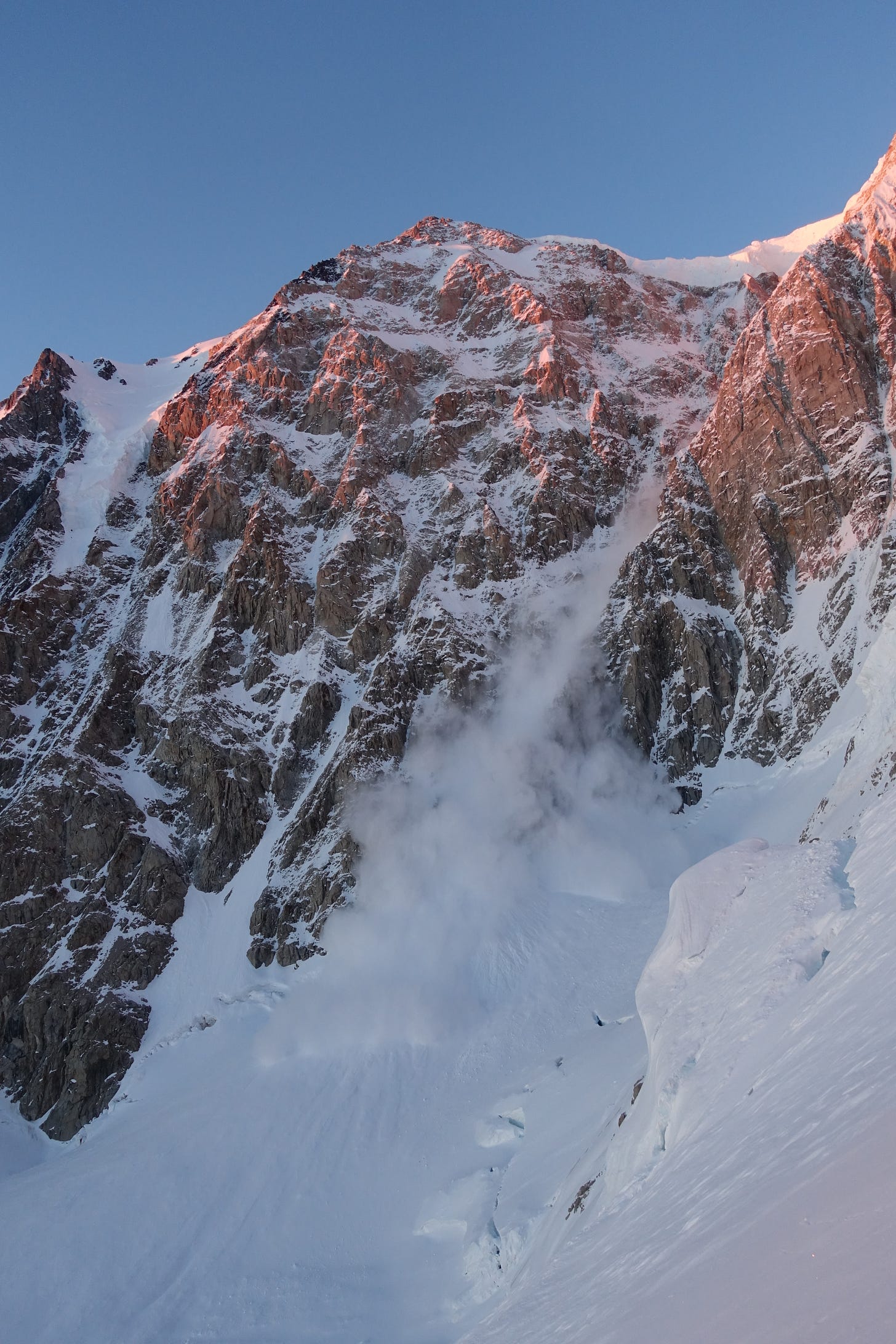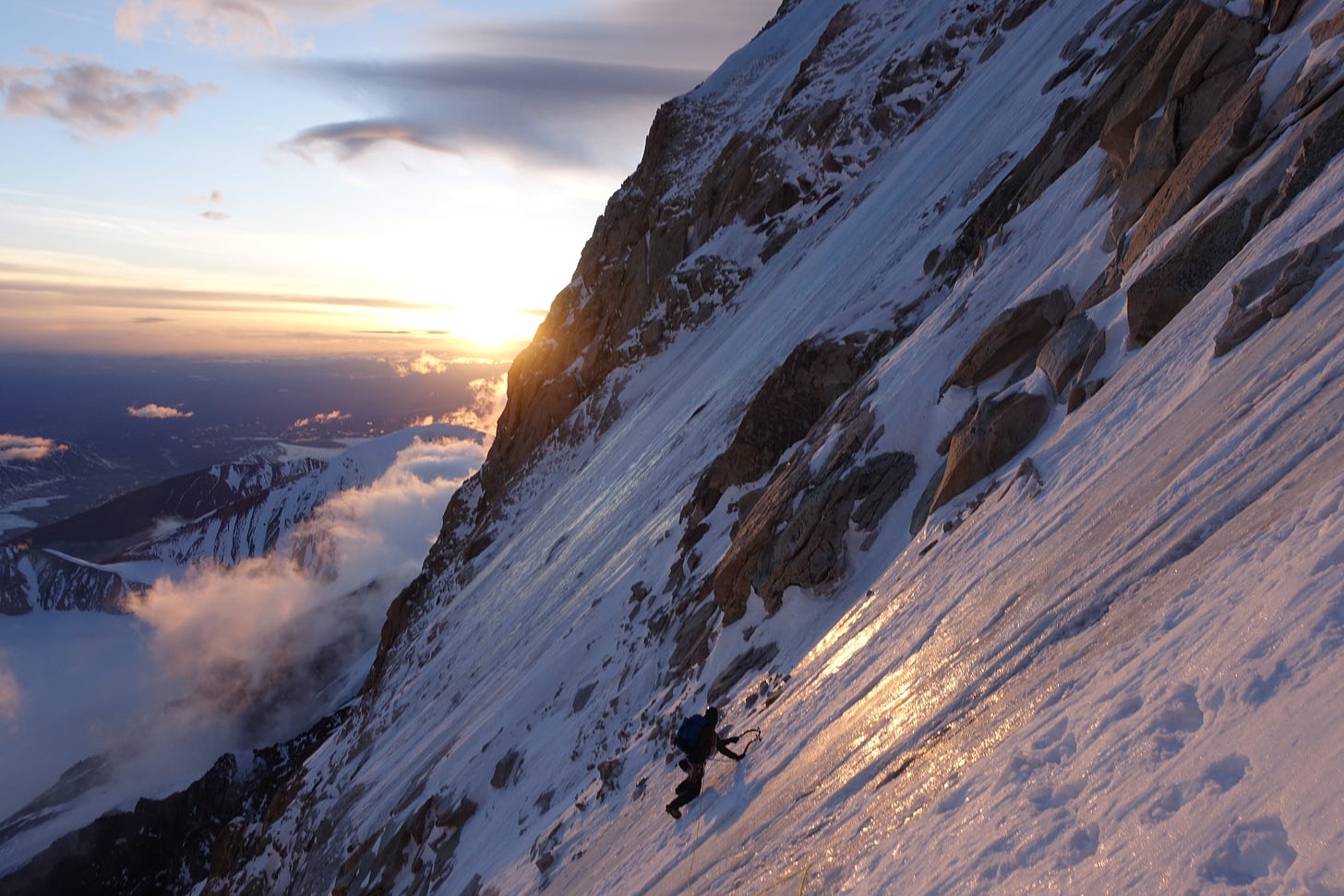This year Mike Gardner and I took our first climbing trip together, supported by the American Alpine Club and Mountain Hardwear’s McNeill-Nott Award. We owe sincere thanks to the American Alpine Club and Mountain Hardwear for supporting our trip financially, and to Sterling Ropes for their sponsorship. Sterling makes great ropes – they handled wonderfully, stayed dry, and kept us warm (as insulation on ice ledges).
We climbed a variation to the Helmuth-House line ‘First Born’ over seventy three hours from May 10-12, 2016. Of that time we spent thirty hours waiting for weather to improve. Ours was the fourth ascent of the Father and Son’s Wall. The route follows ‘First Born’ for its majority, deviating just above the second rock band and returning just above the third rock band. All in all we climbed 500’ of new vertical terrain and about that much contouring back to the line. Since we weren’t there to hug our moms on Mother’s Day, we’re naming it the ‘Mother’s Day’ variation. As for a grade? In the spirit of the past ascents: Alaska Grade 5, Scottish grade VI.
Author’s note, 2024: You just can’t avoid objective hazard on these climbs. Our route started in the couloir to the left of the avalanche runout pictured here. These ran regularly from serac fall from the Upper Peter’s glacier.
“What’s a Scottish grade VI?” Really the only thing we know about Scottish climbing is that it only happens in bad weather. Two of the three routes on Denali’s Father and Son’s Wall were climbed by Scots; one party almost got smoked by an ice avalanche (Guy Willett and Paul Ramsden on ‘The Great White Fright’) and another party claimed they set out with ‘no tent, no sleeping bag, no idea’ (Kenton Cool and Ian Parnell on ‘The Extraterrestrial Brothers’). The first route up the wall was climbed in 1995 by Eli Helmuth and Steve House. Not one party has climbed it to the top. Last year, over pitchers of beer and Brandi Carlile harmonies, Mike Gardner and I traced lines up the few photos we could find.
Dreams / I have dreams / when I’m awake / when I’m asleep
For both of us, it was our second trip into the Alaska Range; we thought it might be over our heads. But, if there’s one thing we’ve learned in our combined experience working on Denali, it’s this: when in Rome, you go big or go home – either way, carpe-fucking-diem.
We staged for two days in Talkeetna before we boarded a de Havilland Beaver (no relation to Castor canidensis, the most industrious of North American fauna) and soared northward in the wash of its throaty roar. Before sun hit the North Buttress of Mt. Hunter and we were camped just off the airstrip. The next morning we jaunted two-thirds of the way up the West Face of Humble Peak before we decided it was too warm to continue. On the way down, we quadrupled the total number of snow bollards we’d ever rappelled off.
Over the next seven days we moved from basecamp (~7000’) up to the 14,000’ basin. As we dragged heavy sleds down the Kahiltna and up the West Buttress, it struck us how karmic our situation was. As guides, we’ve laughed at people anchored by their sleds, but as climbers we were happy no one was around to laugh at us. When we arrived at 14,000’ we planted this year’s flag of civilization.
BEEP. The screen of our sat phone read stacked lows for the next week. It was never terrible, but never good. We tried to get a cache in at the top of the Father and Son’s Wall but turned around when we found scary snow conditions below the fixed lines on the West Buttress. Four days passed in a blur of skiing, gambling in-town beer on card games, and discussing the route and the weather. We thought a lot about the descent – we would either go down to Kahiltna Pass, over Mt. Capps, and up the Peter’s Glacier (4000’ of elevation gain over six miles) or drop off the West Buttress at around 12,000’. We decided the latter meant less walking and more climbing.
We staged for an attempt on a ‘clearing window’ but by the time we arrived at the start of the descent, snow fell. A sucker hole opened as an avalanche ripped across the lower part of the Father and Son’s Wall. When we returned to camp we decided on ‘go’ terms – little to no new snow for 48 hours, sunlight for most of that time, and generally low winds at launch.
After four more days at 14,000’ it looked like we would meet our terms. We got our gear ready. At 6:30 PM we left 14,000’ and descended to the base of Squirrel Hill. We looked at each other, nodded confirmation back and forth, and dropped in.
An easy descent on snow brought us down to a band of seracs. Skirting around them, we arrived at an ice ledge and set a rappel. I landed in an ‘ice moat,’ a feature we’d seen on a topo of the descent. A better description would have been ‘shark’s maw.’ Daggers of glacial ice hung above us. The moat pinched into a gully then and opened up again. I saw some (not small) rocks fall close to my right, through the pinch. I drilled a thread as Mike descended. “Dangerous spot, move fast,” was the extent of our conversation. One more quick rappel landed us underneath a boulder. Sheltered, we took a moment to breathe. There was no going back up that.
Four more rappels brought us to the glacier. We packed up a rope and Mike started across the Lower Peter’s. Bare ice was patched with windblown snow and open crevasses. Halfway across Mike stepped on a patch of snow and disappeared. I was yanked eight feet across the ice before I stopped and started digging frantically. The rope between us slackened, and I stopped digging and started pulling in the slack.
“Mike! Mike!” I yelled. Muffled grunts came out of the hole.
His head poked out of the hole, “Holy shit!” He’d taken a thirty foot crevasse fall and climbed out uninjured.
He led across the rest of the Peter’s and up over the bergschrund to the base of gully at the start of First Born. We’d spent hours tracing lines on our camera screens, and connected a continuous white ribbon from the bottom to the top. This was the most promising option.
We kitted up and clicked on our headlamps as darkness fell. Two thousand feet passed before we stopped to brew up. We turned our headlamps off after we fired the stove, and watched the dawn run to salmon. An hour and a half later Mike climbed out into the first rock band. The Helmuth-House topo suggested we’d find a difficult-to-protect 5.8 rock pitch, but deep snow led to thin ice, and Mike brought me up. Two more pitches of hero ice and fun movement led us through the band to any icy traverse.
Through the first rock band, the wind and snow picked up. When Mike and I switched leads below the second rock band, spindrift began to pour down from above. We couldn’t climb through the cascade, so I climbed across the drainage to an ice arete where we chopped a small ledge, dozed, and traded thoughts.
“We should go down or go up.” / “I’m getting nervous.” / “Let’s listen to music.” / “It’s getting better.” / “It’s not getting better.” / “I can’t get this song out of my head.” / “Not much improvement.” / “Time to go.”
Again, we nodded confirmation back and forth. We rappelled once to gain our line. House describes these pitches as ‘steep waves’ of ice. As I climbed through them I screamed, “Waves! Waves!” Mike yells his agreement as he comes up.
The spindrift started again but one more short pitch brought us to a snow arete. The weather got worse and we chopped an ice ledge. After several attempts to spoon lying down we find the most comfortable position possible – sitting up, our heads on each other and our feet nestled down low. We dragged our shared sleeping bag up over our heads and tucked it behind us. For sixteen hours wind and snow are lost to us. We spoke little and slept less. The remainder of our solid food and Ray Wylie Hubbard’s lyrics fortified us.
The next day we departed in the evening when the winds calmed and the snow stopped. I led up toward curtain of ice flowing down a weakness in the third rock band. Steve and Eli trended left here. More traversing and one steep pitch brought us ‘above the difficulties’ to a broad slope of blue ice. When Mike arrived, we drank deeply from water flowing down the rock wall on our left.
Mike lifted off, but soon realized this ice band didn’t connect to the upper slopes we’d eyed in the photos. He found a block and we rappelled in tandem to the ice bands. Four hundred feet of traversing brought us back in line with ‘First Born.‘
If Hell froze over, it would look like an endless sheet of 50 degree blue ice. To us, salvation appeared as discontinuous runnels of neve. Following the snow the best we could, we simul-climbed the rest of the route; Mike led a few hundred feet until our screws ran out, and then I led until the screws ran out, then Mike led the rest. We gained the top of the ridge around 7:30 AM. The wind was relentless, but the sky was blue. Our remaining rations consisted of two handfuls of gels and nut butter packets and one freeze dried meal.
We decided to wait for improvement before going for the North Summit. After all, that was part of our dream. A small cornice offered some shelter from the wind. We augured in. Two hours later, we awoke cold and shivering to intermittent whiteouts and strong gusts blowing snow into our shelter. We dissolved gels in hot water and sipped the drink to warm ourselves. As we sat there our choice became simpler. Eight hours later, the clouds broke enough to offer quarter-mile visibility, and that’s all we needed. Still, the walk across the Upper Peter’s was breezy.
As we slogged through fresh powder towards the fixed lines we heard a faint “woo hoo!” We looked up to see a group from Alaska Mountaineering School standing on the ridge at the top of the lines. Now, I almost recall that we ran right up and hugged them, but really we were trashed. We trudged up to them and noshed their offered candy. On the walk down to 14,000’, we stopped on a rise, turned to each other with tears in our eyes, and embraced. We stepped into camp seventy three hours after we left. There wasn’t much to say that night, and after dinner, sleep came easy.









